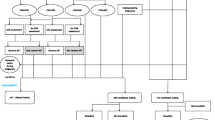Abstract
Mother-to-child transmission (MTCT) of HIV is the most significant source of HIV infection in children below the age of 15 years. In 2000 alone, about 600 000 new infections occurred, the vast majority from mothers living in developing countries who were not aware of their HIV-positive status. To date, at least 4.3 million children have died from AIDS. In this paper, we discuss the development of an operational model that can be used to evaluate intervention options for the prevention of MTCT of HIV. The problem was approached by defining suitable pregnancy risk groups, prevention options and the required model outputs to evaluate different intervention strategies. The method chosen to approach the problem was a discrete-event, three-phase simulation, built in Visual Basic, with a stochastic semi-Markov structure. The developed model takes individual pregnant women through each stage of their pregnancy, labour and birth. Different intervention strategies may be modelled at any time, including short-course antiretroviral drugs and cessation of breastfeeding. The model is demonstrated with data from Botswana, which has one of the highest HIV-infection rates in the world.






Similar content being viewed by others
References
Hooper E (1999). The River: A Journey to the Source of HIV and AIDS. Boston, Little, Brown and Co: New York.
United Nations Special Session on HIV/AIDS (2001). Special Session Bulletin Number, Vol 1. UN: New York.
United Nations Special Session on HIV/AIDS (2001). Technical Background Note on the Draft Declaration of Commitment, prepared by the UNAIDS Secretariat. UN: New York.
Joint United Nations Programme on HIV/AIDS (UNAIDS) (2000). Report on the Global HIV/AIDS Epidemic. Report No. UNAIDS/00.13E. UN: New York.
World Health Organisation (2001). New data on the prevention of mother-to-child transmission of HIV and their policy implications: conclusions and recommendations, WHO Technical Consultation on behalf of the UNFPA/UNICEF/WHO/UNAIDS Inter-Agency Task Team on Mother-to-Child Transmission of HIV. Report No.WHO/RHR/01.28. WHO: Geneva.
Barnhart HX et al (1996). Natural history of HIV disease in perinatally infected children. Pediatrics 97: 710–716.
Joint United Nations Programme on HIV/AIDS and World Health Organisation (1999). HIV in Pregnancy: A Review. Report No. WHO/RHT/98.24, UNAIDS/98.44. WHO: Geneva.
Anderson JG and Anderson MM (1998). HIV screening and treatment of pregnant women and their newborns: a Simulation-based analysis. Simulation 71: 274–284.
UNAIDS (2001). Sources and prices of selected drugs and diagnostics for people living with HIV/AIDS. Joint UNICEF–UNAIDS Secretariat—WHO/HTP Medecins Sans Frontieres Project.
Opportunities and Choices Newsletters . Reproductive Health Research, University of Southampton, UK. www.socstats.soton.ac.uk/choices/publications.html
UNICEF/UNAIDS/WHO/UNFPA . Report from the African Regional Meeting on Pilot Projects for the Prevention of Mother-To-Child Transmission of HIV, Gaborone, Botswana, 27–31, March, 2000.
Shahani AK, Brailsford SC and Roy RB (1994). HIV and AIDS patient care: operational models for resource planning. In: Kaplan EH and Brandeau ML (eds). Modelling the AIDS Epidemic: Planning, Policy and Prediction. Raven Press: New York.
Shahani AK et al (1994). Towards an operational model for the prevention and treatment of asthma attacks. J Opl Res Soc 45: 916–926.
Tocher KD (1963). The Art of Simulation. English Universities Press: London.
Hawkins JD et al (1992). TOCHSIM Manual. Southampton Centre for Operational Research, Faculty of Mathematical Studies, University of Southampton: Southampton.
Winslett DJ (1999). Modelling for maternity care during pregnancy and labour. MSc dissertation, Faculty of Mathematical Studies, University of Southampton: UK.
Harper PR et al (2001). Classification trees: a possible method for maternity risk grouping. IMH Preprint, Faculty of Mathematical Studies, University of Southampton, UK.
Dickson GW, Desanctis G and McBridge DJ (1986). Understanding the effectiveness of computer graphics for decision support: a cumulative experimental approach. Comm ACM 29: 40–47.
Chau PYK and Bell PC (1995). Designing effective simulation-based decision support systems: an empirical assessment of three types of decision support systems. J Opl Res Soc 46: 315–331.
Acknowledgements
This research has benefited from the expert knowledge afforded by many clinicians working within the field of MTCT of HIV. In particular, we would like to express out thanks to Dr Ratish Basu Roy, Dr Harry Harindra, Dr Anton Pozniak and Dr Will Stones. As a consequence of this valuable input, we hope that the model presented here captures realistic and up-to-date issues of the MTCT natural history, and available interventions. We are grateful for the financial support received from DfID and the Opportunities and Choices Programme.
Author information
Authors and Affiliations
Corresponding authors
Rights and permissions
About this article
Cite this article
Vieira, I., Harper, P., Shahani, A. et al. Mother-to-child transmission of HIV: a simulation-based approach for the evaluation of intervention strategies. J Oper Res Soc 54, 713–722 (2003). https://doi.org/10.1057/palgrave.jors.2601566
Received:
Accepted:
Published:
Issue Date:
DOI: https://doi.org/10.1057/palgrave.jors.2601566




